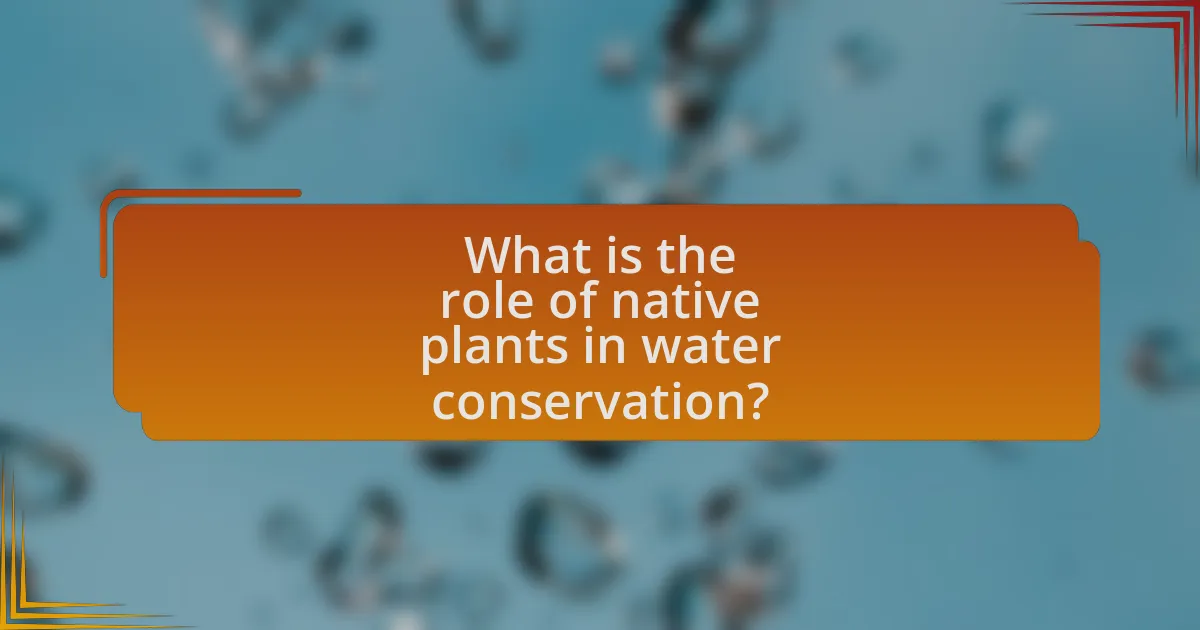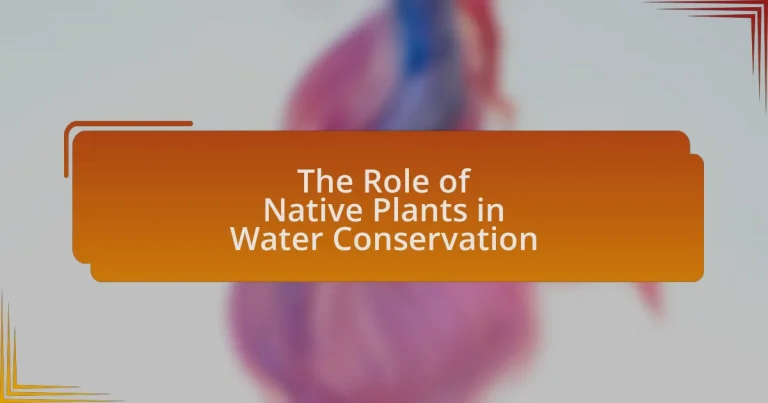Native plants are essential for water conservation, as they enhance soil moisture retention and reduce irrigation needs. Their deep root systems improve soil structure, allowing for better water infiltration and retention, leading to significant water savings—up to 50% less compared to non-native species. This article explores the mechanisms by which native plants contribute to water retention, their adaptations for drought resistance, and their ecological benefits, including support for biodiversity and erosion prevention. Additionally, it discusses practical steps for communities and individuals to implement native plants in landscaping for improved water management.
What is the role of native plants in water conservation?

Native plants play a crucial role in water conservation by enhancing soil moisture retention and reducing the need for irrigation. Their deep root systems improve soil structure, allowing for better infiltration and retention of rainwater. Studies show that native plants require significantly less water compared to non-native species, which often demand more irrigation and can lead to water depletion. For instance, research from the University of California indicates that landscapes with native plants can reduce water usage by up to 50%. This efficiency not only conserves water but also supports local ecosystems by providing habitats for wildlife.
How do native plants contribute to water retention in ecosystems?
Native plants contribute to water retention in ecosystems by enhancing soil structure and promoting moisture retention. Their deep root systems improve soil aeration and water infiltration, allowing more water to be absorbed and stored in the ground. Additionally, native plants often have adaptations that reduce water loss, such as waxy leaves or smaller leaf surfaces, which help maintain moisture levels in the soil. Research indicates that ecosystems dominated by native vegetation can retain up to 30% more water compared to those with non-native species, demonstrating their critical role in water conservation.
What mechanisms do native plants use to enhance soil moisture?
Native plants enhance soil moisture through mechanisms such as deep root systems, mulching, and transpiration. Deep root systems allow native plants to access water stored deeper in the soil, which helps maintain moisture levels even during dry periods. Additionally, the organic matter from fallen leaves and plant debris creates a natural mulch that reduces evaporation and retains moisture in the soil. Transpiration, the process by which plants release water vapor, can also contribute to local humidity, promoting moisture retention in the surrounding soil. These mechanisms collectively support soil moisture conservation, which is crucial for ecosystem health and resilience.
How do root systems of native plants affect water infiltration?
Root systems of native plants significantly enhance water infiltration by creating channels in the soil that facilitate the movement of water. These root systems, often deep and extensive, improve soil structure and porosity, allowing water to penetrate more effectively. Research indicates that native plants can increase water infiltration rates by up to 50% compared to non-native species, as their roots help break up compacted soil and promote the formation of soil aggregates. This process not only aids in water absorption but also reduces surface runoff, contributing to better water conservation in ecosystems.
Why are native plants more effective than non-native species in conserving water?
Native plants are more effective than non-native species in conserving water because they have adapted to local climates and soil conditions, allowing them to utilize water more efficiently. These plants typically possess deep root systems that access groundwater and are more resilient to drought conditions, reducing the need for supplemental irrigation. Research indicates that native plants can reduce water usage by up to 50% compared to non-native species, which often require more water to thrive in unfamiliar environments. This efficiency in water use is crucial for sustainable landscaping and ecosystem health.
What adaptations do native plants have for drought resistance?
Native plants exhibit several adaptations for drought resistance, including deep root systems, reduced leaf surface area, and water-storing tissues. Deep root systems allow these plants to access moisture from deeper soil layers, which is crucial during dry periods. Reduced leaf surface area minimizes water loss through transpiration, while water-storing tissues enable the plants to retain moisture for extended periods. These adaptations are essential for survival in arid environments, where water availability is limited.
How do native plants interact with local climate conditions?
Native plants adapt to local climate conditions by developing specific traits that enhance their survival and growth in those environments. For instance, many native plants possess deep root systems that allow them to access groundwater during dry periods, which is crucial in arid climates. Additionally, they often have leaves that are adapted to reduce water loss, such as waxy coatings or smaller surface areas, which help them conserve moisture. Research indicates that native plants can improve soil health and water retention, further supporting local ecosystems and reducing the need for irrigation. This interaction between native plants and local climate conditions demonstrates their essential role in maintaining ecological balance and promoting water conservation.
What are the ecological benefits of using native plants for water conservation?
Using native plants for water conservation provides significant ecological benefits, including improved water retention and reduced erosion. Native plants are adapted to local climates and soil conditions, which allows them to thrive with minimal irrigation, thus conserving water resources. Additionally, their deep root systems enhance soil structure, promoting better infiltration and reducing runoff. Research indicates that landscapes with native vegetation can absorb up to 30% more rainfall than those with non-native species, leading to increased groundwater recharge. Furthermore, native plants support local wildlife, contributing to biodiversity and ecosystem stability, which are essential for maintaining healthy water cycles.
How do native plants support biodiversity in water conservation efforts?
Native plants support biodiversity in water conservation efforts by providing habitat and food sources for various species, which enhances ecosystem resilience. Their deep root systems improve soil structure and water retention, reducing runoff and erosion. Studies show that areas with native vegetation can retain up to 30% more water than those with non-native species, promoting healthier aquatic ecosystems. Additionally, native plants are adapted to local climates and soil conditions, requiring less irrigation and thereby conserving water resources. This adaptability contributes to the overall health of the ecosystem, supporting a diverse range of flora and fauna.
What role do native plants play in preventing soil erosion?
Native plants play a crucial role in preventing soil erosion by stabilizing the soil with their root systems. These roots bind the soil together, reducing the likelihood of soil displacement caused by wind and water. Research indicates that native plants are particularly effective in maintaining soil structure and health, as they are adapted to local environmental conditions and can thrive in various climates. For example, a study published in the journal “Ecological Applications” found that areas with native vegetation experienced significantly less erosion compared to those dominated by non-native species. This effectiveness is attributed to the deep and extensive root systems of native plants, which not only anchor the soil but also enhance water infiltration, further mitigating erosion risks.
How can communities implement native plants for better water management?
Communities can implement native plants for better water management by incorporating them into landscaping and restoration projects, which enhances soil health and reduces runoff. Native plants are adapted to local climates and soils, requiring less water and maintenance compared to non-native species. Research indicates that using native vegetation can improve water infiltration rates by up to 50%, thereby reducing erosion and promoting groundwater recharge. Additionally, native plants support local ecosystems, providing habitat for wildlife and contributing to biodiversity, which further aids in maintaining healthy water cycles.
What challenges might arise when integrating native plants into landscaping?
Integrating native plants into landscaping can present challenges such as limited availability of specific native species, potential incompatibility with existing non-native plants, and the need for specialized knowledge regarding native plant care. Limited availability can hinder the selection process, as not all nurseries stock a diverse range of native plants, making it difficult for landscapers to find suitable options. Incompatibility issues may arise when native plants do not thrive alongside established non-native species, which can outcompete them for resources. Additionally, specialized knowledge is often required to understand the specific growing conditions and maintenance needs of native plants, which may not be familiar to all landscapers or homeowners.
What practical steps can individuals take to promote the use of native plants for water conservation?
Individuals can promote the use of native plants for water conservation by educating themselves and their communities about the benefits of these plants. Native plants require less water, as they are adapted to local climates and soil conditions, which reduces the need for irrigation.
To further this effort, individuals can participate in or organize workshops and community events focused on native gardening, showcasing how to incorporate native plants into landscaping. Additionally, advocating for local policies that support the use of native plants in public spaces and encouraging local nurseries to stock native species can significantly enhance their visibility and accessibility.
Planting native species in personal gardens not only conserves water but also supports local wildlife, creating a more sustainable ecosystem. Research indicates that native plants can reduce landscape water use by 50% compared to non-native species, highlighting their effectiveness in water conservation efforts.
How can homeowners select appropriate native plants for their gardens?
Homeowners can select appropriate native plants for their gardens by researching local ecosystems and understanding which species thrive in their specific region. This involves consulting local extension services, native plant societies, or botanical gardens that provide information on native flora suited to the local climate and soil conditions. For instance, the U.S. Forest Service emphasizes that native plants are adapted to local environmental conditions, making them more resilient and requiring less water than non-native species. By choosing plants that are indigenous to their area, homeowners can enhance biodiversity, support local wildlife, and contribute to water conservation efforts.
What maintenance practices support the health of native plants in water conservation efforts?
Regular maintenance practices that support the health of native plants in water conservation efforts include mulching, proper irrigation management, and invasive species control. Mulching helps retain soil moisture, reducing the need for additional watering, while proper irrigation management ensures that native plants receive adequate water without overwatering, which can lead to root rot. Invasive species control is crucial as non-native plants can outcompete native species for resources, ultimately diminishing their health and effectiveness in water conservation. These practices collectively enhance the resilience of native plants, contributing to sustainable water management.


